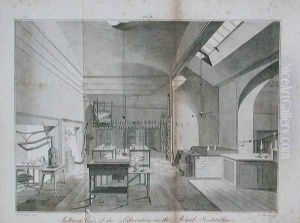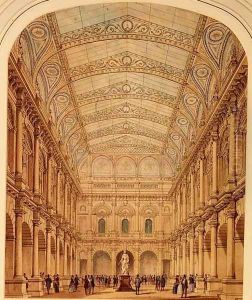William Tite Paintings
William Tite was a distinguished British architect born on February 7, 1798, in Kew, Surrey, England. Tite's career spanned much of the 19th century, a period marked by significant developments in architectural styles and urban planning. He is best remembered for his work on public buildings, railway stations, and his contribution to cemetery design, which reflected the era's evolving architectural tastes and technological advancements. Tite was educated at a private school in Brompton and showed an early interest in architecture. His formal training began under the tutelage of David Laing, with whom he worked on the Customs House. Tite's career was notable for its focus on the design of commercial buildings and infrastructure, which was crucial during a time of rapid urbanization in Britain.
Tite's most significant contribution was to the design of the Royal Exchange in London, completed in 1844. This building, which replaced an earlier structure destroyed by fire, was lauded for its classical design, incorporating Corinthian columns and a grand portico, emblematic of the city's commercial prestige. The Royal Exchange became one of London's iconic landmarks, illustrating Tite's ability to blend functionality with grandeur. Beyond his architectural achievements, Tite was also involved in urban planning, particularly in the development of railway infrastructure. He designed several railway stations, including the Carlisle Citadel station, which helped facilitate the expansion of the railway network across Britain, a critical factor in the country's industrial growth.
Tite's work extended beyond commercial and transport architecture. He was a pioneer in the design of cemeteries, an important aspect of Victorian urban development due to the public health concerns of the time. His designs for the West Norwood Cemetery in London are notable examples, where he employed a range of architectural styles, from Egyptian to Gothic, reflecting the Victorian fascination with the exotic and the medieval. This work underscored the era's changing attitudes towards death and commemoration, blending aesthetic considerations with public health needs.
William Tite was not just a practicing architect but also an influential figure in architectural education and professional organizations. He was a Fellow of the Royal Society, served as President of the Royal Institute of British Architects (RIBA), and was a Member of Parliament, where he advocated for architectural and urban planning issues. Tite's contributions to architecture and urban planning were recognized during his lifetime; he was knighted in 1851 for his work on the Royal Exchange.
Tite passed away on April 20, 1873, in Torquay, Devon. His legacy is seen not only in the buildings and infrastructure he designed but also in his impact on the architectural profession and urban planning in Britain. William Tite's career reflects the complexities and challenges of 19th-century architecture, demonstrating a blend of aesthetic beauty, functional design, and urban sensibility that characterizes the era's architectural achievements.


